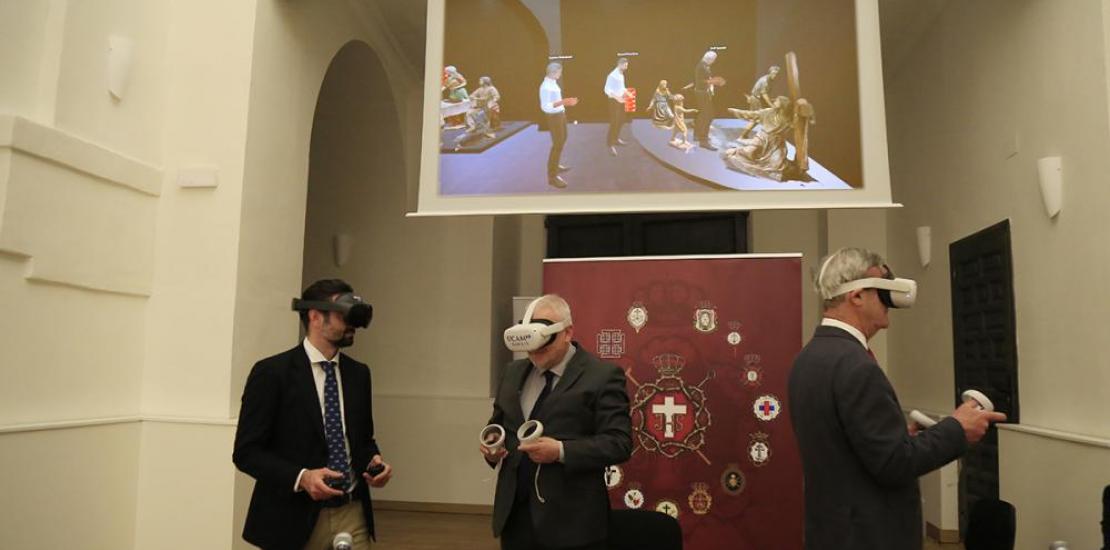UCAM has transformed the Museum of the Christ of Blood into the first "cofrade" metaverse
José Ignacio Sánchez, President of the Council of Fraternities in Murcia, has described the use of this technology as an "international novelty" that allows anyone to enjoy a fully "real" visit
"It is impressive, it's like being in the Museum" he said. This has been the most repeated phrase by José Ignacio Sánchez, President of the Cabildo Superior de Cofradías de Murcia; Samuel Mendoza, General Director of Infrastructure and Digital Development at UCAM, and Carlos Valcárcel, President of the Archicofradía de la Sangre de Murcia, during a visit to the Museum of this Archicofradía through its metaverse, the first of its kind related to fraternities in Spain, at an event held at the Council's headquarters.
This metaverse was presented during the event, created thanks to the collaboration between the Archicofradía del Cristo de la Sangre and the Degree in Telecommunications Engineering at UCAM, which offers the user the possibility of visiting religious images as a real experience. The most innovative aspect of this work is that, through virtual reality glasses, the user can take a completely immersive visit, entering the Museum to contemplate the figures, thanks to the use of photogrammetry, a technique that precisely defines the shape, dimensions, and position of an object. Anyone who wishes to do so can now experience this immersive experience through the spatial.io website.
José Ignacio Sánchez congratulated the Archicofradía de la Sangre and UCAM "for creating this virtual museum. It is an international novelty that can be appreciated from anywhere in the world; it is an opportunity to further enhance our Holy Week."
This project is part of the Digital Transformation Strategic Plan of the Catholic University of Murcia, with Samuel Mendoza stating that "we have created a unit of digital content in which there is a sub-department of virtual reality" to highlight "the importance of bringing Christian culture to all platforms, and how to promote them is one of the missions of our university."
Rafael Melendreras, Vice Dean of the Degree in Telecommunications Engineering at UCAM, has been one of the main drivers of this metaverse, who, after several years of work with his team of researchers, has achieved the virtualization of the entirety of the Museum's heritage, which, as he explains, "offers an unprecedented immersive experience, in which four centuries of passion sculpture in Murcia can be appreciated."
On his part, Carlos Valcárcel has stated that "even though it's virtual, it's a space that never fails to confuse you with reality. We are very grateful to UCAM and we are willing to continue carrying out this type of projects, because it is an immense and attractive field to develop."
Final Degree Project of a Telecommunications Engineering student
The idea arose from the Final Degree Project of Miguel Alcaraz, a student of Telecommunications Technologies Engineering at UCAM, who virtualized one of the rooms of the Museum, which was the first step into the metaverse in the field of heritage conservation in the Region of Murcia. As a result, the project was continued, resulting in the recreation of the entire space.
This work is not an isolated case at the Catholic University of Murcia, as the institution has been immersed in a permanent process of digital transformation for years, which is integrated into both its campus facilities and services, as well as its teaching methodology. Tools such as virtual reality, clinical simulation, supercomputing, high-definition streaming, or artificial intelligence are part of its Strategic Plan, and now also augmented reality and mixed reality, key immersive technologies in the development of the metaverse. Over 3,000 UCAM students have had an immersive educational experience to this day, including students from its degrees in Telecommunications Engineering and Computer Engineering, both integrated into its School of Engineering.




